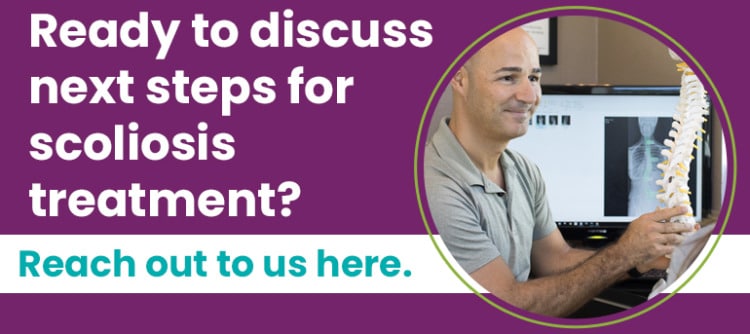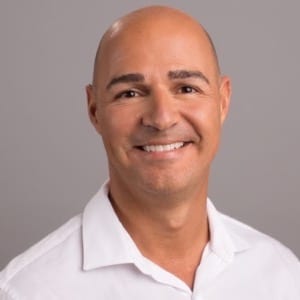When Does Scoliosis Become a Serious Concern? Warning Signs
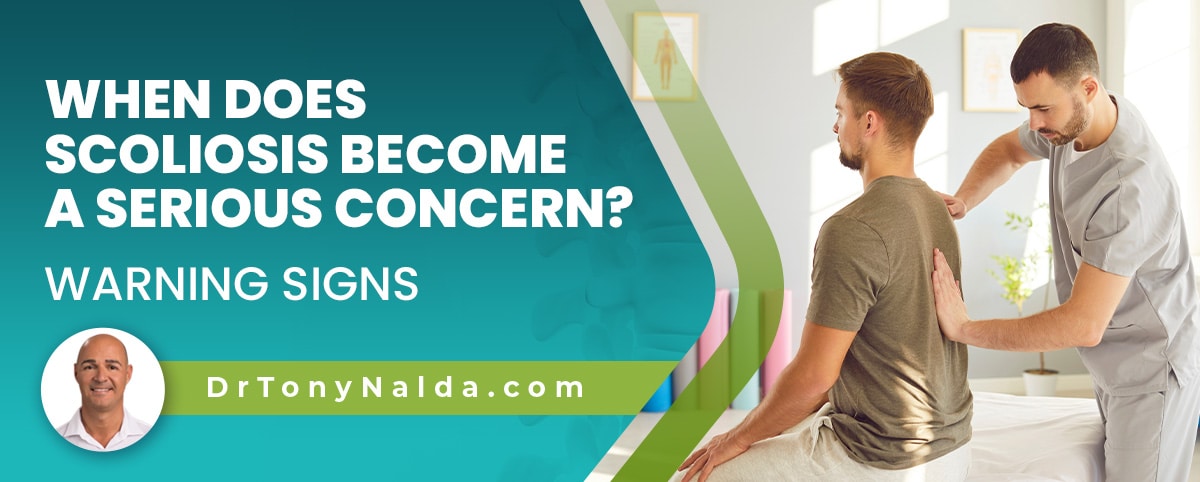
The warning signs of scoliosis aren't always overt, which is why early detection isn't always easy. Early detection means diagnosing conditions while they are still mild and are the most likely to respond well. The warning signs of scoliosis in children involve postural changes, and the main symptom of adult scoliosis is pain.
Although scoliosis ranges widely in severity from mild to very severe, all levels should be a concern because as a progressive condition, the nature of scoliosis is to get worse over time. Ideally, scoliosis treatment should be started immediately following a diagnosis to prevent progression.
The sooner scoliosis treatment is started, the better, and the milder scoliosis is when treatment is applied, the more likely treatment success is, but first, conditions have to be diagnosed.
Table of Contents
Diagnosing Scoliosis Isn't Always Easy
Scoliosis is a highly-prevalent spinal condition that causes an unhealthy sideways-bending curvature of the spine to develop.
As scoliosis causes the spine to twist, in addition to bending unnaturally to the side, scoliosis is a 3-dimensional condition.
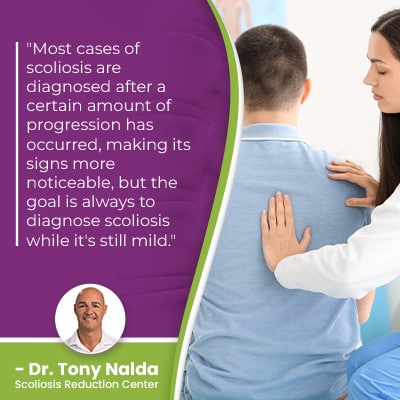 Most cases of scoliosis are diagnosed after a certain amount of progression has occurred, making its signs more noticeable, but the goal is always to diagnose scoliosis while it's still mild.
Most cases of scoliosis are diagnosed after a certain amount of progression has occurred, making its signs more noticeable, but the goal is always to diagnose scoliosis while it's still mild.
Scoliosis is a progressive condition that's virtually guaranteed to get worse over time, and this makes the spine increasingly rigid, less responsive to treatment, and makes the condition's signs more overt.
Here at the Scoliosis Reduction Center®, most of my patients are diagnosed with moderate scoliosis because it's once mild scoliosis progresses to moderate that its signs tend to become noticeable enough to lead to assessment and diagnosis.
Scoliosis is diagnosed through the combined results of a physical examination that includes an Adams forward bend test and taking the patient's family history and medical history to look for risk factors.
Scoliosis X-Ray
If the physical examination finds condition indicators present, further testing is warranted in the form of a scoliosis X-ray.
An X-ray is needed to fully see what's happening in and around the spine, to determine a patient's Cobb angle, curvature location, curvature type, and the angle of trunk rotation (ATR).
Children are most often diagnosed with scoliosis, and childhood scoliosis isn't associated with pain as a symptom, which is one of the main reasons early detection of childhood scoliosis isn't always easy.
Scoliosis doesn't become a compressive condition until skeletal maturity has been reached, and it's compression of the spine and its surroundings that causes the majority of condition-related pain.
Growing spines are experiencing a constant lengthening motion that counteracts compression, but once growth stops, conditions become compressive and pain develops as a noticeable symptom of scoliosis.
Scoliosis pain can involve the muscles, the back, and radiating pain into the extremities.
Postural Changes can be Subtle
The main symptoms of scoliosis in children involve postural changes caused by the condition's uneven forces disrupting the body's overall symmetry.
The earliest signs of childhood scoliosis are often uneven shoulders, uneven shoulder blades, and uneven hips.
The most prevalent form of scoliosis is adolescent idiopathic scoliosis diagnosed between the ages of 10 and reaching skeletal maturity, and this age group isn't exactly known for good posture and their willingness to share bodily changes with parents and/or caregivers.
In fact, in many cases of adolescent idiopathic scoliosis, postural changes are noticed by patients long before they're diagnosed; many adolescent patients want to conceal these changes and are embarrassed by them, and when an active effort is being made to counteract the condition's effects, the body can compensate in a number of ways.
In many instances, parents notice postural changes while on beach vacations and observing their child in a bathing suit that can't hide the types of changes occurring.
Additional postural changes can include the development of a rib cage arch, arms and legs that hang at different lengths, and changes to balance, coordination, and gait are also common.
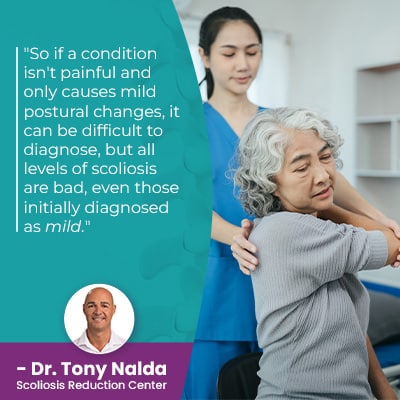 So if a condition isn't painful and only causes mild postural changes, it can be difficult to diagnose, but all levels of scoliosis are bad, even those initially diagnosed as mild.
So if a condition isn't painful and only causes mild postural changes, it can be difficult to diagnose, but all levels of scoliosis are bad, even those initially diagnosed as mild.
Scoliosis Severity
Scoliosis ranges widely in severity from mild scoliosis to moderate scoliosis, severe and very severe scoliosis, and condition severity is determined by a measurement known as Cobb angle.
A patient's Cobb angle is a key piece of information that treatment plans are shaped around, but scoliosis isn't a static condition; it's always changing.
Where a scoliosis is at the time of diagnosis doesn't guarantee that's where it will stay. Only proactive treatment can work towards counteracting the condition's progressive nature.
The higher a patient's Cobb angle, the more severe the condition. The measurement is taken during X-ray by drawing lines from the tops and bottoms of the vertebrae that are the most unnaturally tilted, and the resulting angle is expressed in degrees.
- Mild scoliosis: diagnosed with Cobb angle measurements of between 10 and 25 degrees
- Moderate scoliosis: diagnosed with Cobb angle measurements of between 25 and 40 degrees
- Severe scoliosis: diagnosed with Cobb angle measurements of 40+ degrees
- Very-severe scoliosis: diagnosed with Cobb angle measurements of 80+ degrees
The most important thing to understand about scoliosis is that all levels are bad because as a progressive condition, it's likely to get worse over time.
A major risk of increasing condition severity and progression is the need for more invasive forms of treatment.
Severe Scoliosis Surgery
One of the main goals of a proactive conservative scoliosis treatment approach is to prevent the need for surgical treatment.
Surgical treatment for scoliosis is a type of spinal fusion that fuses the curve's most-tilted vertebrae into one solid bone to prevent more movement (progression), and metal rods are commonly attached to the spine to hold it in place.
Fusing the spine often involves the removal of intervertebral discs sitting between adjacent vertebrae to be fused.
While the procedure can straighten a bent spine and hold it in place, the methodology of the procedure is contrary to the spine's movement-based design and can cost the spine in terms of its general strength and function.
Traditional Surgical Treatment
For those on the path of traditional scoliosis treatment, scoliosis isn't addressed while mild because there is no strategy to do so in place; instead, conditions are monitored, patients are commonly told to watch and wait for progression, and when/if a condition progresses into the severe classification at 40+ degrees, spinal fusion surgery is commonly recommended.
So the worse scoliosis gets, the more likely future surgery is because conditions are more complex to treat.
There are also atypical condition types of scoliosis that are known to be particularly severe, including neuromuscular scoliosis that's caused by the presence of larger neurological disorders such as spina bifida, cerebral palsy, and muscular dystrophy.
In atypical types of scoliosis with known causes, curves can bend to the left, towards the heart; in typical cases of idiopathic scoliosis, an unnatural curvature of the spine will bend to the right, away from the heart.
When I see left-bending curves on an X-ray, this is a warning sign that the scoliosis has an underlying pathology and will likely be severe with unique characteristics and treatment needs.
The goal of conservative treatment is to prevent conditions from becoming severe, while maintaining as much of the spine's natural strength and function as possible.
Conclusion
All severity levels of scoliosis are bad because as a progressive condition triggered by growth, it's always changing.
Warning signs that scoliosis is progressing and getting worse include symptoms becoming more noticeable, and in children, this includes postural changes and disruptions to movement, and in adults, pain will increase, along with postural and movement changes.
As the main symptom of adult scoliosis is radiating pain due to nerve compression, increasing back, muscle (muscle spasms), and nerve pain means the scoliosis is progressing and becoming more complex to treat.
The most common type of scoliosis to affect all ages is idiopathic scoliosis, and adolescent idiopathic scoliosis is the most prevalent type overall; additional condition types include neuromuscular scoliosis, degenerative scoliosis, and congenital scoliosis.
Most types of structural scoliosis have it in their nature to progress, and while there are no treatment guarantees, with early detection and intervention, there are fewer limits to what non-surgical treatment can achieve.
Scoliosis that's addressed successfully with conservative treatment will minimize scoliosis symptoms, reduce the size of the unnatural spinal curve, and spare patients the hardships associated with spinal fusion surgery.
So when is scoliosis bad? It's bad when it develops, but it can be highly treatable, particularly when diagnosed early and treated proactively.
Dr. Tony Nalda
DOCTOR OF CHIROPRACTIC
After receiving an undergraduate degree in psychology and his Doctorate of Chiropractic from Life University, Dr. Nalda settled in Celebration, Florida and proceeded to build one of Central Florida’s most successful chiropractic clinics.
His experience with patients suffering from scoliosis, and the confusion and frustration they faced, led him to seek a specialty in scoliosis care. In 2006 he completed his Intensive Care Certification from CLEAR Institute, a leading scoliosis educational and certification center.
About Dr. Tony Nalda
 Ready to explore scoliosis treatment? Contact Us Now
Ready to explore scoliosis treatment? Contact Us Now